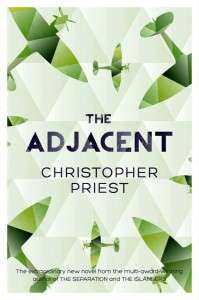The Adjacent
Christopher Priest
Titan Books
Publication Date: June 20, 2013
ISBN 978-1-78116-943-8
The Adjacent was a frustrating read. A glorious, wondrous, frustrating read.
You see, I’m not all that good with puzzles. Things that are linear, sure, but when they start jumping around and requiring sideways or deductive reasoning based on conclusions that are not strongly drawn – forget it! And The Adjacent is, first and foremost, a puzzle, when looked at as a whole.
If, however, you are good at puzzles, or if you are willing to take things as they come, or if you simply enjoy superb writing, then you will thoroughly enjoy The Adjacent.
Set as separate vignettes of time, from the near future – around the middle of this century – when the world has been roughly affected by the effects of climate change and an Islamic sensitivity has become prevalent, to Europe (specifically Britain and Poland) during World War II, to a self-isolated unknown island country of Prachous, where characters may or may not meet their end, the action is constantly in flux.
Just when we start to settle in to one place and one set of characters, the next section of the book takes us in an entirely different direction, often with seemingly no relation to the section(s) that came before. We brush up against luminaries such as H. G. Wells (real) and Professor Thijs Reitveld (fictitious), the inventor of the Perturbative Adjacent Field (PAF), also known as the adjacency defense, and who, much like those who worked on the Manhattan Project, lived to see his findings be applied to what was to become known as The Weapon That Will End War. But we also meet everyday people going about their lives, such as Mike “Floody” Torrance, airman mechanic attached to 148 Squadron, Bomber Command No. 5 Group, based at RAF Tealby Moor, or news photographer Tibor Tarent who is returning to England after a devastating assignment in Turkey, and Thom the Thaumaturge, an accomplished magician and conjurer for hire in Beathurn, one of Prachous’ most cosmopolitan cities.
Yet even as disjunctive as the individual sections might seem, they increasingly build into echoes of each other, sometimes pulling strongly in still-hidden sensibilities and at other times echoing with just a whisper. There is one thing that binds them, all these characters in all these places – in each section, in each world and each individual experience, life is in conflict – due to war, to personal loss, to convention or to circumstance, or in a combination of any or all of these. Crisis – either real or implied – is either right on the doorstep or else only one step away.
The writing in The Adjacent is incredibly detailed and vivid, bringing each iteration in time, each landscape and climate into clear focus, but there is also a sleight of hand constantly at play. Becoming aware of this, the reader starts to look for connections, for triggers, just like one does when watching a talented street performer – you have one eye cocked for misdirection and you’re constantly looking to catch the explanation behind the trick. But Christopher Priest is too good to tip his hand in any way; even when you think you’ve figured out where he’s going, he still manages to surprise and delight.
I’m not sure, even after reading the book and ruminating on it for a few days, if I truly “understand” the full story of The Adjacent. But then, I’m not sure I’m meant to, or if I need to. While it may be the ultimate purpose of a puzzle to be solved, prestidigitation is instead rooted in entertainment. So perhaps The Adjacent is less a puzzle, and more an illusion – a very well worked illusion. What I do know is, whether taken in parts or as a whole, The Adjacent certainly is entertaining, even if you are left at the end wondering, “How’d he do that?”

